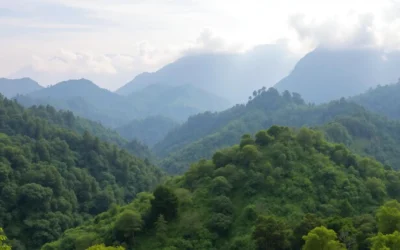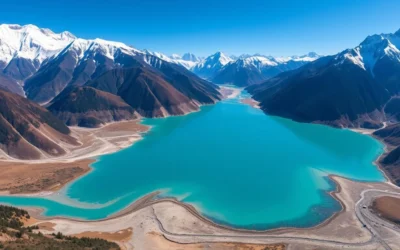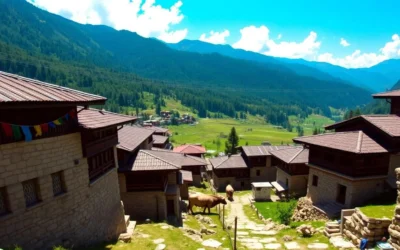Did you know that Jigme Dorji National Park is the only place on Earth where you can find snow leopards and tigers sharing the same habitat? Spanning an impressive 4,316 square kilometers (1,667 square miles), this breathtaking protected area is where Bhutan’s national animal (takin), national flower (blue poppy), national bird (raven), and national tree (cypress) all coexist in one magnificent ecosystem.
The breathtaking landscape of Jigme Dorji National Park showcases Bhutan’s pristine wilderness
Getting There & Planning Your Journey
Reaching Jigme Dorji National Park begins with flying into Paro International Airport, Bhutan’s only international gateway. From Paro, the southern boundary of the park is approximately a three-hour drive. Most visitors access the park through organized tours that handle the necessary permits and transportation logistics.

The traditional entrance gateway to Jigme Dorji National Park welcomes visitors
All foreign visitors to Bhutan must book through licensed Bhutanese tour operators who will arrange your Sustainable Development Fee (SDF), visa, and all necessary permits for entering the national park. Independent travel is not permitted in Bhutan, making advance planning essential.
Ready to Start Your Bhutan Adventure?
Find the best flight deals to Paro International Airport and begin your journey to Jigme Dorji National Park.
Best Time to Visit Jigme Dorji National Park
Timing your visit correctly is crucial for enjoying the park’s natural splendor. The climate varies dramatically across the park’s three distinct zones: alpine, temperate, and subtropical.

Spring brings spectacular rhododendron blooms throughout the park’s valleys
Recommended Seasons
Spring (March to May)
Temperatures range from 10°C to 22°C (50°F to 72°F). This is an ideal time for wildlife spotting and botanical enthusiasts as rhododendrons and blue poppies bloom spectacularly across the valleys. The weather is generally stable with clear mountain views.
Autumn (September to November)
Temperatures range from 5°C to 18°C (41°F to 64°F). The post-monsoon period offers crystal-clear skies, making it perfect for trekking and photography. The landscapes transform with golden hues, and visibility of distant peaks is at its best.
Avoid: The monsoon season (June to August) brings heavy rainfall, making trails slippery and dangerous. Winter (December to February) can be extremely cold at higher elevations with temperatures dropping below -10°C (14°F), and many high-altitude passes become inaccessible due to snow.
Getting Around Locally
Navigating Jigme Dorji National Park requires careful planning and proper transportation arrangements. The park’s vast size and varying terrain demand appropriate methods of exploration.

Local guides and pack horses are essential for multi-day treks through the park
Transportation Options
Guided Treks
The most authentic way to experience the park is on foot with experienced local guides. Treks range from day hikes to the challenging multi-week Snowman Trek. Your tour operator will arrange porters and pack animals for longer expeditions.
Vehicle Access
4WD vehicles can reach certain areas of the park, particularly the southern sections. However, most of the park’s interior is only accessible by foot. Your tour operator will arrange appropriate transportation to trailheads.
Need Transportation in Bhutan?
Secure reliable transportation for your Bhutan adventure with our trusted partners.
Important: All visitors must be accompanied by licensed Bhutanese guides within the national park. Independent exploration is not permitted. Your guide will handle all necessary permits and ensure you follow park regulations.
Where to Stay
Accommodation options within and around Jigme Dorji National Park range from basic trekking camps to comfortable lodges. Your choice will depend on your itinerary and comfort preferences.

Traditional Bhutanese homestays offer authentic cultural experiences with stunning views
Accommodation Options
Camping
For multi-day treks, camping is often the only option. Tour operators provide all necessary equipment including tents, sleeping bags, and cooking facilities. Campsites are basic but located in breathtaking settings.
Homestays
In villages like Laya and Lingzhi within the park, homestays offer a glimpse into traditional Bhutanese life. Accommodations are simple but comfortable, with authentic home-cooked meals included.
Nearby Hotels
For those exploring just the southern edges of the park, hotels in Thimphu, Punakha, and Paro provide comfortable bases. These range from 3-star to luxury 5-star properties with modern amenities.
Find Your Perfect Stay in Bhutan
Browse accommodations near Jigme Dorji National Park and secure your booking today.
Dining & Local Cuisine
Bhutanese cuisine is distinctive and flavorful, with a focus on spicy dishes and locally grown ingredients. During your visit to Jigme Dorji National Park, you’ll have various opportunities to sample authentic local food.

A traditional Bhutanese meal featuring the national dish ema datshi (chili cheese) with red rice
What to Eat
Local Specialties
- Ema Datshi – Bhutan’s national dish of chili peppers and cheese
- Suja – Traditional butter tea, perfect for cold mountain mornings
- Jasha Maru – Spicy chicken stew with tomatoes and chilies
- Red Rice – Nutty, mineral-rich rice grown in high-altitude valleys
- Momos – Dumplings filled with cheese, vegetables, or meat
Dining Options
- Trek Meals – On multi-day treks, your guides will prepare fresh meals at campsites
- Homestay Dining – Authentic home-cooked meals shared with local families
- Village Restaurants – Simple eateries in larger settlements like Laya
- Hotel Restaurants – More varied options in towns outside the park
Dietary Note: Vegetarian options are widely available, though pure vegan meals may be more challenging to find. Inform your tour operator about any dietary restrictions in advance.
Attractions, Sightseeing & Activities
Jigme Dorji National Park offers a wealth of natural and cultural attractions that showcase Bhutan’s rich biodiversity and heritage. From challenging treks to sacred sites, there’s something for every type of traveler.

The sacred Mount Jomolhari (7,326 m) is reflected in an alpine lake at dawn
Natural Highlights
Mount Jomolhari
Known as the “Bride of Kangchenjunga,” this 7,326 m (24,035 ft) peak is sacred to Tibetan Buddhists. The mountain is believed to be the home of the goddess Jomo, and climbing to its summit is forbidden. However, trekking to Jomolhari Base Camp offers spectacular views.
Glacial Lakes
The park contains numerous pristine alpine lakes, many considered sacred. These turquoise gems are nestled among towering peaks and offer perfect photography opportunities. Some lakes require specific permits due to their religious significance.

The rare Bhutan takin, the country’s national animal, can be spotted in remote valleys
Wildlife Encounters
The park is home to numerous endangered species, though spotting them requires patience and luck. Some notable inhabitants include:
- Snow Leopard – The park’s most elusive predator, occasionally spotted in winter
- Bengal Tiger – Remarkably shares habitat with snow leopards at higher elevations
- Bhutan Takin – The national animal, a unique goat-antelope hybrid
- Red Panda – Found in bamboo forests at mid-elevations
- Blue Sheep (Bharal) – Often seen on rocky slopes and meadows
- Himalayan Black Bear – Inhabits forested regions throughout the park

The historic Lingzhi Dzong fortress has guarded mountain passes for centuries
Cultural Sites
Lingzhi Dzong
This 17th-century fortress sits at 4,150 m (13,615 ft) and currently houses around 30 monks. Originally built to protect northern borders, it offers insights into Bhutan’s defensive architecture and Buddhist traditions.
Gasa Dzong
Also known as Gasa Tashi Tongmon Dzong, this fortress serves as the administrative center for Gasa District. The dzong houses important religious artifacts and showcases traditional Bhutanese architecture.
Experience the Best of Jigme Dorji National Park
Book guided tours and trekking experiences with expert local guides.
Trekking & Outdoor Adventures
Jigme Dorji National Park is a trekker’s paradise, offering some of the most challenging and rewarding hiking routes in the Himalayas. From day hikes to multi-week expeditions, there’s a trail for every ability level.

Trekkers cross a high mountain pass adorned with prayer flags on the Jomolhari Trek
Popular Treks
Jomolhari Trek
Duration: 7-8 days
Difficulty: Moderate to challenging
Highlights: Views of Mount Jomolhari, traditional villages, diverse ecosystems, and possible wildlife sightings. The trek reaches elevations of 4,890 m (16,043 ft) at Nyile La pass.
Laya-Gasa Trek
Duration: 11-12 days
Difficulty: Challenging
Highlights: Remote villages, hot springs at Gasa, unique culture of the Layap people, and spectacular mountain scenery. This trek is an extension of the Jomolhari route.
Snowman Trek
Duration: 25-30 days
Difficulty: Extremely challenging
Highlights: Considered one of the world’s toughest treks, crossing multiple high passes above 5,000 m (16,404 ft). Only recommended for experienced high-altitude trekkers.

Campsites on multi-day treks are often situated beside pristine mountain streams
Day Hikes
For those with limited time or trekking experience, several day hikes are available from the park’s southern boundary:
- Jigme Dorji National Park Trail – 9.3 km (5.8 miles) out-and-back trail with 750 m (2,461 ft) elevation gain
- Dodena to Cheri Monastery – A moderate 2-3 hour hike with cultural significance
- Thimphu to Tango Monastery – A popular day hike with beautiful forest views
Trekking Safety: All treks in Jigme Dorji National Park require proper acclimatization and preparation. Altitude sickness is a real risk, with many routes crossing passes above 4,000 m (13,123 ft). Always trek with experienced guides and proper equipment.
Safety, Etiquette & Local Customs
Visiting Jigme Dorji National Park requires respect for both the natural environment and local cultural traditions. Understanding proper etiquette will enhance your experience and ensure you’re a responsible visitor.

Visitors should observe proper etiquette when visiting monasteries and religious sites
Cultural Respect
- Dress modestly when visiting religious sites – shoulders and knees should be covered
- Remove hats and shoes when entering temples and monasteries
- Ask permission before photographing people, especially monks
- Walk clockwise around religious structures (chortens, prayer wheels, mani walls)
- Speak softly near religious sites and during ceremonies
Environmental Responsibility
- Follow “Leave No Trace” principles – pack out all trash
- Stay on designated trails to prevent erosion and habitat damage
- Do not collect plants, rocks, or other natural items
- Maintain a safe distance from wildlife – never feed or approach animals
- Use biodegradable soap and respect water sources
Local Interaction: The people of remote villages like Laya have unique customs and dress. When visiting these communities, your guide will explain appropriate behavior and facilitate respectful interactions.
Practical Travel Tips
Proper preparation is essential for a successful visit to Jigme Dorji National Park. These practical tips will help you plan effectively and avoid common pitfalls.

Proper packing and preparation are essential for trekking in Jigme Dorji National Park
Essential Packing List
Clothing
- Layered clothing for variable temperatures
- Waterproof jacket and pants
- Sturdy hiking boots (well broken-in)
- Warm hat, gloves, and thermal underwear
- Sun hat and UV-protective sunglasses
Equipment
- Headlamp with extra batteries
- Water purification tablets or filter
- High SPF sunscreen and lip balm
- Personal first aid kit with altitude sickness medication
- Trekking poles for steep sections
Health & Safety
- Altitude sickness is a real concern – allow time for proper acclimatization
- Drink plenty of water and avoid alcohol at high elevations
- Consider purchasing travel insurance with emergency evacuation coverage
- Bring any prescription medications you need – pharmacies are limited
- Mobile phone coverage is extremely limited within the park
Administrative Requirements
- All visitors need a Bhutan visa arranged through a tour operator
- The Sustainable Development Fee (SDF) is mandatory for all tourists
- Special permits are required for certain areas within the park
- Photography permits may be needed for some religious sites
Plan Your Bhutan Adventure Today
Ready to experience the wonders of Jigme Dorji National Park? Start planning your journey now.
Conclusion
Jigme Dorji National Park represents the soul of Bhutan – a pristine wilderness where ancient traditions and rare wildlife thrive together. From the sacred peaks of Mount Jomolhari to the remote villages of Laya, this remarkable protected area offers experiences that will stay with you long after you’ve returned home.
Whether you’re trekking through alpine meadows, photographing blue poppies in bloom, or connecting with local communities, Jigme Dorji National Park embodies Bhutan’s commitment to conservation and Gross National Happiness. As you plan your journey to this Himalayan sanctuary, remember that the rewards of visiting such a special place come with the responsibility to protect and respect it.
Ready to walk among clouds and ancient forests? Jigme Dorji isn’t just a park—it’s where Bhutan’s soul roams wild.
The above is subject to change.
Check back often to TRAVEL.COM for the latest travel tips and deals.






